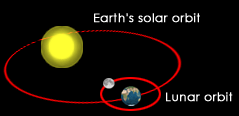bᵊ-Reish•itꞋ 4th Eve
Earth Orbits The Sun, Moon Orbits Earth
Cosmic Yom Rᵊviy•iyꞋ (Fourthday)


As the earth passed by the star we call our sun, the sun's gravity captured the earth into a solar orbit. This probably occurred before the moon later passed nearby earth and was captured by earth's gravity, in an orbit around the earth.
So now the moon orbits the earth as the earth orbits the sun. Our orbit around the sun causes the seasons of our earthly 365¼ day year: spring, summer, autumn and winter.
While all this is happening, the earth is also spinning on its axis, making an earthly, 24 hour, day and night, and the moon orbits the earth every 28 days.
Together, these provide a means of indexing whatever happens to a particular point in the orbits of the sun and moon, our place in the Milky Way galaxy as we orbit its center and the position of our galaxy in the expanding universe. We call this time. We use this procession of our universe to tag and index history, marking the point in the procession of the universe that things happen.
Spring, summer, autumn and winter are all an expression of time — in which quadrant the earth is traveling in its orbit around the sun.
How far the earth has spun on a certain day we read as the time "of day". It takes 24 hours to spin one complete revolution. In Tor•âhꞋ, the day begins in the evening, at sunset; as the earth spins eastward away from the sun. The rest of the world lags a bit behind, starting the day a few hours later, at midnight.
Because the earth is a globe, while some places on earth face the sun and it's daytime, other places face away from the sun so it's night there. Different places on earth have different times of the day.
Where the earth is in its orbit around the sun we call the day of the year.
You can't feel it but you're traveling through our galaxy, through the universe, our solar system is circling the center of our galaxy, our earth is orbiting the sun and where you're sitting our earth is spinning about the speed of a bullet, making one complete revolution every day. So right now, while you feel like your sitting still, you're actually traveling through the universe at about 650 km/sec. — 1⅓ x the entire length of Israel every second!
This was the fourth cosmic ërꞋëv followed by cosmic morning: defining the fourth cosmic yom of our universe.

Optional parental preparation:
- Swing ball on a string to demonstrate orbital forces
- Use a flashlight and globe to demonstrate the earth spinning eastward; sunrise, sunset.
- Watch a sunrise and sunset, explaining how the sun is stationary while the earth is rotating relative to the sun.
- Preview beforehand and show video: https://www.youtube.com/watch?v=jgoIP90apEs
Questions you might anticipate that your child might raise and be prepared to discuss:
- What is gravity? (review)
- What is an orbit? (review)
- What are the seasons? What causes our seasons? (offset of earth's rotational axis as it orbits the sun)
- Why are the seasons opposite in the northern hemisphere from the southern hemisphere?
Google+ registered author & publisher

